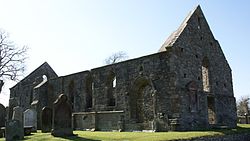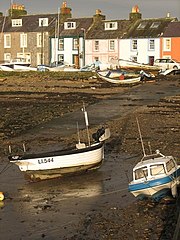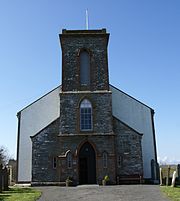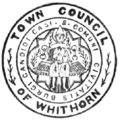Whithorn
| Whithorn | |
| Wigtownshire | |
|---|---|
 The Old Priory | |
| Location | |
| Grid reference: | NX445405 |
| Location: | 54°44’6"N, 4°24’58"W |
| Data | |
| Population: | 867 (2001) |
| Post town: | Newton Stewart |
| Postcode: | DG8 |
| Dialling code: | 01988 |
| Local Government | |
| Council: | Dumfries and Galloway |
| Parliamentary constituency: |
Dumfries and Galloway |
Whithorn is a town and royal burgh in Wigtownshire, standing on the coast about ten miles south of Wigtown. The town was the location of the first recorded Christian church in northern Britain, named Candida Casa; the 'White House', built by Saint Ninian in 397.
Whithorn's link to the sea was the port known as the Isle of Whithorn, which was much used in the Middle Ages by pilgrims arriving by boat. The thirteenth century St Ninian's Chapel marked the point where pilgrims came ashore (the roofless remains are looked after by Historic Scotland).
The 1st century settlement of Rispain Camp, about 1 mile west of Whithorn is also in the care of Historic Scotland.
Name of the town
Whithorn first appears in the written record in Bede's Ecclesiastical History of the English People in the 8th century, in which he calls it Candida Casa ("white house"). 'Whithorn' is an English version of the name, or rather an Old English version; in the Anglo-Saxon period it was called Hwit Ærne, 'white house'. By Bede's time it was an active English monastery and the seat of a bishopric.
In the Galloway Gaelic, the town was called Futarna, a rendering of the English name (as Gaelic has no sound corresponding to the English 'wh').[1] The name Rosnat appears too, which some believe might refer to Whithorn.
Isle of Whithorn

Isle of Whithorn is a small village on the coast, 5 miles southeast of Whithorn where Wigtown Bay opens into the Irish Sea.
The village is not on an island despite its name, though the original Isle of Whithorn is, or was, an island. There is a small isle, with the remains of a fort, earthworks and a few cottages. Now joined to the mainlan by a causeway, this was the original Isle of Whithorn, and it is here that the remains of Ninian's Chapel are found. The island forms one side of Isle of Whithorn Bay, the village's natural harbour.
In the Middle Ages, pilgrims coming to Whithorn would land by sea at the Isle of Whithorn and pray at the chapel. This stopped at the Reformation and the Isle of Whithorn became just a fishing village.
Church

The parish church is St Ninian's Priory. The old dissolved priory lies in ruins beside today's church, which retains its name within the Church of Scotland.
History
Foundation
According to Bede, Ninian evangelised the Southern Picts from Whithorn in the fourth century, establishing his chapel here; the earliest recorded Christian foundation in Britain beyond Hadrian's Wall. Bede is the only source we have for Ninian, some four centuries before, and all other tales of his works are much later and based on no more than pious mediæval romance.
Eighth to twelfth centuries
A monastery and diocese of the Anglo-Saxon kingdom of Northumbria was founded on the site in the 8th century, and Bede was most familiar with the monastery, relating its foundation and the various bishops closer to his own time.
Whithorn Abbey was the centre of the revived See of Galloway (or Candida Casa) under the patronage of Fergus, Lord of Galloway and Bishop Gille Aldan from the 12th century. The late mediæval cathedral priory is ruinous, much of it having disappeared completely apart from the much-altered aisleless nave and vaults at the former eastern end which once held the shrine of St Ninian, one of mediæval Scotland's major pilgrimage destinations. King Robert I made a pilgrimage to Whithorn seeing a cure for an illness, and granted the town a burgh charter.
The pilgrimages were forbidden at the Reformation and the shrine destroyed. The relics over which the superstitious pilgrims has prayed were destroyed too, apart from a casket said to contain a bone of Ninian, which was spirited away to France, and destroyed at the French Revolution.
A museum in the town contains finds from the site, which has been extensively excavated in recent years. A late mediæval gateway with the arms of the King of Scots leads into the site of the priory, which contains the 19th century parish church and a museum of carved stones. The collection of early mediæval stones is one of the largest in Scotland, and includes the country's earliest surviving Christian memorial, the 5th century inscribed 'Latinus Stone'. The museum layout and display was revised and greatly improved in 2005.
The crozier
One of the finest artefacts found at the site is the Whithorn crozier. The gilded and enamelled crozier is an outstanding example of champlevé enamels which were being made in England in the second half of the 12th century, and this one dates to around 1175.[2] It is now housed in the National Museums of Scotland, although it is loaned to the Whithorn Trust Visitor Centre every summer. It is thought that the crozier was buried with the body of Simon de Wedale, who was one of the Bishops of Whithorn.
Pictures
-
George Street
-
Seal of the Burgh of Whithorn (from a 1906 book)
-
Whithorn Priory
-
Remains of the Priory Nave at Whithorn
-
The Monreith Cross in the Whithorn Museum.
Railway
Whithorn was once served by a railway station until the Beeching axe.
Outside links
- Community website
- Information site
- Whithorn Priory on Undiscovered Scotland
- Whithorn Evergreens
Notes and references
- Glenn, V. (2003) Romanesque and Gothic: decorative metalwork and ivory carvings in the Museum of Scotland, Edinburgh: Museum




